Chapter 4 Nursery: facilities and culture of post-larvae
4.1 NURSERY FACILITIES
Two methods of settling larvae are used at the model hatchery/nursery in Bermuda. The first involves the setting of pediveligers on a downwelling system of sieves in a raceway and continued rearing fixed spat until they reach at least 2? mm in shell height?? spat may be kept in this system until they reach 5–10 mm shell height.
This method requires continuous monitoring in the nursery and is labour intensive; nonetheless, it maximizes survival of spat to the juvenile stage. The second system, involves the setting of larvae on cultch (or artificial substrate) submerged in a circular tank for a shorter rearing time until spat reach 1 mm shell height. In this latter system, spat are transferred to the natural environment on a suspended culture system of longlines within one month of settlement. This method, maximizes space in the hatchery, however, survival to juvenile stage (5–10 mm shell height) is reduced. The method chosen depends on the specific strategies selected by the hatchery and on conditions prevalent in the field at the time of transfer. Facilities for both methods are shown here as they are both used in Bermuda.
However, should one be chosen over the other, modifications can be easily made to the facility.
4.1.1 Semi-recirculating raceway system (indoor)
Refer to Technical Drawing – page 14. Colour codes are similar to that of other diagrams, in that ambient seawater is coded blue, outflow is coded purple and semi recirculating flow is coded white.
The raceways are two 200x60x15 cm deep fiberglass flow-troughs, with blue gel coated interior and grey pigmented exterior (Red-Ewald Inc.), mounted on a side wall, one above the other, and supported by a wooden frame (60x130 cm). For protection against saltwater the wooden frame is coated with several layers of epoxy. Each raceway has a 25 mm drain hole into which a 25 mm male adapter can be threaded and fitted with an overflow standpipe.
Seawater for the raceway is diverted from the mainline fastened to the ceiling, containing ambient seawater filtered to 1 µm. Diversion is created by a 40 mm T. Flow to the raceway system is regulated by a 40 mm one-way ball valve. A 40 mm union allows for dismantling and cleaning of system. The 40 mm pipe is reduced to 25 mm using a 40 mm to 25 mm bushing. Seawater flow is divided between the top and bottom raceway as it passes through a 25 mm T. Flow is regulated individually to each raceway through a 25 mm ball valve. The fitting of 25 mm unions after each ball valve facilitates cleaning of the pipes at the beginning and end of season. A 25 mm elbow directs the flow into the raceway. This therefore provides ambient seawater to the raceways. For the rearing of spat, the system is usually connected as a semi-recirculating system, where a constant inflow of ambient seawater is provided and partial recirculation of seawater is set. This minimizes the waste of algal food cells provided to the spat and can also be used to control seawater temperature, if needed, during the settlement phase. Note: seawater control can be affected by manipulating seawater temperature in the sump tank.
For the semi-recirculation system, a 220 litres sump tank is located on the floor next to the bottom raceway. Overflow of the sump tank is at the top through a 40 mm pipe and spills onto the floor. Discharge rate can be easily monitored using this overflow. Seawater is pumped from the bottom of the tank by a quiet vertical pump (P 95V).
Details and dimensions are given in technical drawing – 1/15A. Water pumped from the bottom of the sump tank passes through a 25 mm pipe affixed to the wall of the container above the raceways. The recirculation pipe follows the length of the lower raceway, bends upward towards the upper raceway through two elbows, and passes through a 25 mm valve H. This valve is an additional control to the flow of water in the raceways. The 25 mm seawater line continues above the upper raceway and runs to the end of the raceway where a 25 mm elbow directs the flow of water through a one-way ball valve (Valve I) to the sump tank. This recirculated water is supplied to the raceways through 8 mm holes drilled into the pipe running the length of the raceway
Technical drawing, Pg. 14
Nursery: Semi-recirculating raceway system section
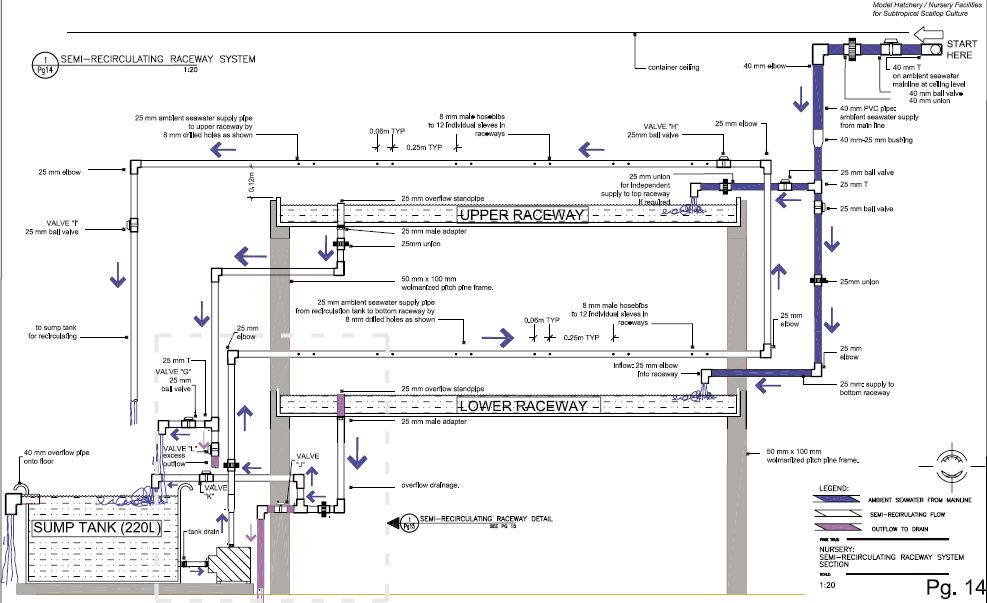
sand fitted with male hose barbs. Tygon tubing connected to these hose barbs are cut in pieces long enough to reach individual sieves suspended in the raceway.
Flow for each raceway is therefore twofold: 1) Incoming flow from the ambient seawater line at the right hand side of the raceway, which flows directly into the raceway trough and empties into the sump tank via the drain; and 2) Seawater flow from the sump tank system supplying each sieve separately. A constant water level is maintained in each raceway by the overflow standpipe. Each standpipe is connected to a 25 mm line fitted under the raceway and connected to a 25 mm union for dismantling and cleaning of pipes. A T-junction diverts the water back to the sump tank for recirculation or directly to the outside through the container wall draining into the external 100 mm drain system. The system is identical for both raceways. For the upper raceway, control of flow to drain is regulated by Valve L; for the lower raceway, it is controlled by Valve J.
The degree of semi-recirculation is controlled by Valves K, G, H and I regulating flow into the sump tank, and by Valves J and L, regulating the degree of water discarded from the raceway overflow. To achieve equilibrium, valves are opened in the following manner: Valves H and I are wide open; Valves G and K are 3/4 opened, and valves J and L are fully closed. Any excess water flows out of the sump tank through the overflow pipe. The last two valves J and L are only opened for cleaning of raceways.
4.1.1.1 Details of sump tank
Refer to Technical Drawing – page 15A. Details in Diagram 1/Pg15A show a close-up of connections required. The sump tank drain is a thru-hull fitting (20 mm) connected to the vertical pump via a 20 mm pipe and male adapter. This pump is supplied with 20 mm fittings. The outflow of the vertical pump is conducted through a 20 mm female adapter. Water passes through a 20–25 mm bushing increasing the pipe size to 25 mm. A union facilitates the removal of the pump at this end, and the adapter fittings on either end of the pump aid in its replacement when needed.
The seawater line from the pump is taken back to the wall of the container, and runs parallel to the container wall to supply the raceways (see technical drawing photo – 3/pg15A). Once water has passed along raceway contours (as described in the technical drawing – page 14) it is returned to the sump tank. Additional recirculation is provided from the overflow pipe of each raceway, where seawater is passed through a 25 mm T-junction and controlled by Valve G for the upper raceway, and Valve K for the lower raceway. For cleaning of the raceways and complete drainage, Valves G and K are closed, and outflow is diverted through Valves L and J (upper and lower raceway respectively) for discard (see technical drawing photo – 2/pg15A).
Refer to Technical Drawing – page 15B. The sump tank with overflow discharge and incoming flow is illustrated in Diagram 1/Pg15B. The relative positioning of both raceways and sump tank is seen in Diagram 2/Pg15B. Finally, the sieves used for post-larval rearing and suspended in the raceway, are set as a downwelling system in Diagram 3/Pg15B with incoming seawater flowing into each sieve. Two 25 cm diameter sieves can be placed widthwise and with a total of 12 sieves per raceway. Sieves are suspended by 15 mm transverse pipes resting on the top of the raceway.
4.1.2 Outdoor raceway
Refer to Technical Drawing – page 16A. An experimental outdoor raceway is used to grow 2 mm spat to >5 mm, a size suitable for transfer to 3 mm mesh pearl nets for growout. This is found beneficial as survival following transfer at sea is observed to be dependent on size of spat at transfer. In this outdoor nursery spat are reared in sieves, similar to the indoor raceway, but of slightly larger diameter (30 cm) and of larger mesh
Technical drawing, Pg. 15A
Nursery: Sump tank detail

Technical drawing, Pg. 15B
Nursery: Semi-recirculating system photographs
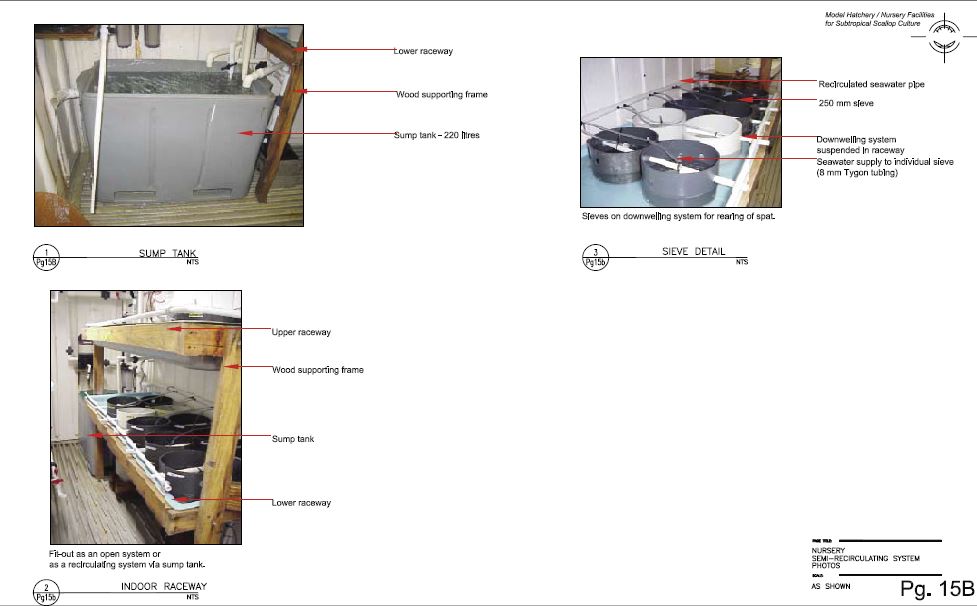
size (1.2 mm). The system is an upwelling system as opposed to the indoor raceway which is a downwelling system. Seawater and algal supply are supplied at one end of the raceway and passed through the bottom of each sieve flowing out at the top of the sieve. It is found that older spat have better growth and survival when reared in such an upwelling system. In this way spat are not trapped with faecal or detritus material present in the water.
Technical diagram photo 2/Pg16A illustrates the outdoor raceway. It is built on a concrete slab of 3.35x2 m. This support pad is made of a 150 mm reinforced concrete slab on grade. The raceway is constructed of 20 mm, exterior grade plywood coated with polyester resin on all surfaces in contact with seawater. The construction is strengthened by a middle timber brace made of 130x60 cm marine plywood. The entire plywood construction is seated on 4 concrete block series at each corner; raceway channels are thus at waist level and facilitate working. A rooftop, made of corrugated plastic, and fixed onto a wooden frame and 4 wooden posts (130x60 cm), bolted into the trough system, provides shade and protection from debris and rain to the raceway. For further protection for the sides of the raceway, drop-down, fly screen panels are fitted to the canopy.
Refer to Technical diagram – 1/Pg16A. The raceway is 2.56 m in length and is divided lengthwise into 3 sections: a 15 cm wide central drainage channel and two completely separate 43 cm wide raceway channels. These interconnect with the drainage channel via six 2.5 cm diameter drain holes. Coarsely filtered ambient seawater is supplied directly to the raceway from the pump house. T-junction (T7), diverting water from the main line to the exterior raceway is also shown in the overall layout of the facility in the technical drawing – page 1 (Chapter 1). Seawater flow, diverted from the mainline, is regulated by a 50 mm one-way ball valve (Valve M). This point on the line is also one of the lowest points on the entire line and has a 50 mm drain pipe going into the sea for emptying the entire line at the beginning and end of the season. In this drain line, a T-junction diverts the water directly to the outdoor raceway and a 50 mm union valve (Valve N) placed directly afterwards is opened completely when the outdoor raceway is used. The third valve (Valve O) on the other side of the T-junction is only opened for cleaning of the seawater system pipes.
A 50 mm line is laid around the periphery of the cement pad, using 50 mm elbows when required, and clean-out valves are located at the ends to facilitate cleaning of the pipes. On the diagram, clean-out T’s shown are associated with bends following the contour of the land not seen in the diagram. Direct inflow of seawater to each raceway channel is provided through a 40 mm pipe. Each raceway channel and central drainage channel has a 40 mm drain, at the opposite end of incoming flow, made of a 40 mm male adapter fitted with an overflow standpipe. Effluent water is then discarded through a 100 mm drain pipe laid on the concrete pad. Seawater supply to the raceway is illustrated and magnified in the technical drawing diagrams – 1Pg16B and 2/Pg16B; for additional clarity a front elevation drawing is given in technical drawing – 2/Pg 17.
The outdoor raceway is thus an open seawater system, with supply coming from the pump house, flowing into each raceway channel from the left hand side of the diagram and flowing out at the opposite end of the raceway, where it is discharged.
4.1.2.1 Seawater supply to outdoor raceway
Refer to Technical Drawings – pages 16B and 17. Seawater inflow to raceway is magnified in the technical drawing diagrams – 1/Pg16B and 2/Pg16B. From the T-junction, water is equally distributed to both raceway channels; a 40 mm union is connected on both sides of the T-junction and flow to the raceways is regulated
Technical drawing, Pg. 16A
Outdoor raceway: Plan view and photos
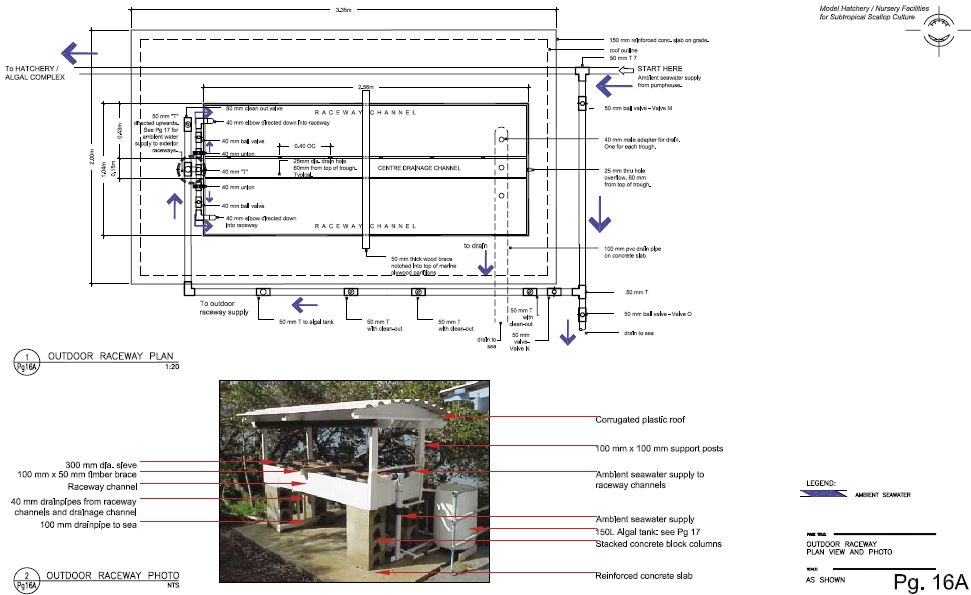
Technical drawing, Pg. 16B
Outdoor raceway: Details and photographs
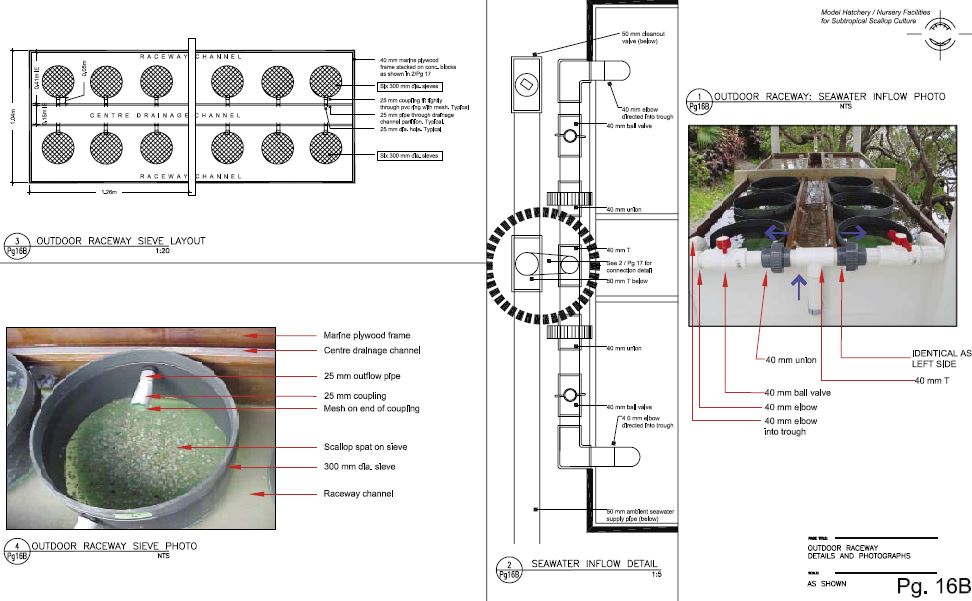
through 40 mm ball valves. An elbow pointing downwards directs the flow into the raceway. Unions fitted in line allow for replacement of parts and cleaning of pipes.
The front elevation of supply to the raceway is depicted in the technical drawing diagram – 2/Pg17. From the main seawater supply running on the ground along the periphery of the concrete pad, flow is directed upwards via a T-junction capped with clean-out valve for maintenance purposes. A 50 mm union is fitted in-line for ease of dismantling followed by a 50–40 mm bushing reducing the seawater supply line to 40 mm. The line runs in the middle of the raceway frame to the top of the channels; at this point, seawater is equally diverted to both raceway channels via a 40 mm T-junction.
4.1.2.2 Sieve layout
Refer to Technical Drawing – 3/Pg16B and 4/Pg16B. Each 25 mm drainage pipe connecting the raceway channel to centre drainage channel is fitted with a 25 mm coupling and pipe connected to each sieve. Sieves are 30 cm diameter, 10 cm high with a 1.06x0.72 mm (1.2 mm diagonal) mesh bonded to its base. This provides for a total of 12 spat holding sieves when the raceway is fully utilized.
The procedure for making sieves is similar to that described in Appendix 17. The mesh used to line the bottom is the same as that used for green collector bags with an aperture size of 1.2 mm on the diagonal. Fitting of the sieves to the raceway and outflow system differed from the indoor raceway system. A 25 mm hole is drilled onto the top of the sieve, through which a 25 mm pipe is tightly secured, extending on either side of the sieve wall by 50 mm. A 25 mm coupling is fitted into the 25 mm pipe in the interior of the sieve. The opening of the coupling is closed by a piece of 1.2 mm mesh to prevent any spat from flowing out. The overflow pipe is secured into the wall of the trough by tightening it into the drilled hole (see technical drawing photo – 4/Pg16B). Sieves are suspended off the bottom; and water flow is directed so as to move through the bottom mesh and out at the top of the sieve into the centre drainage channel, causing an upwelling movement.
Note: The system can readily be adapted for a downwelling flow by inputting water into the central channel and discharging the waste water through 40 mm diameter drainage pipes at the outflow end of each raceway compartment. In this case, the flow enters the sieve at the top and flows vertically downwards through the mesh of the sieves.
4.1.2.3 Outdoor raceway elevations and algal supply
Refer to Technical Drawings – page 17 and page 18). Colour codes for seawater are blue and purple for ambient supply and outflow; additionally, algal supply is coded in green.
The side elevation diagram (see technical drawing – 1/Pg17) depicts the plastic cylindrical tank used as an algal reservoir (56 cm diameter, 75 cm high tank; Volume of 150 l). In order to allow for supply or outflow of algae and seawater, three 20 mm holes are drilled into the wall of the tank. Two holes, on opposite sides of the tank, are close to the top and one is at the bottom. Position of the holes can be seen in the photos (see technical drawings – 1/Pg18 and 2/Pg18). The holes are sealed with an O-ring and fitted with a 20 mm female adapter to 20 mm male adapter to make a watertight connection.
There is a small demand for seawater supply to the algal tank on a daily basis for diluting of algal ration and cleaning of tank. For this purpose, the ambient seawater line coming from the pump house is first diverted to fill the algal tank (see technical drawings – 1/Pg17 and 1/Pg18). It is immediately reduced to 20 mm by a 50 mm to
Technical drawing, Pg. 17
Outdoor raceway and algal supply elevations
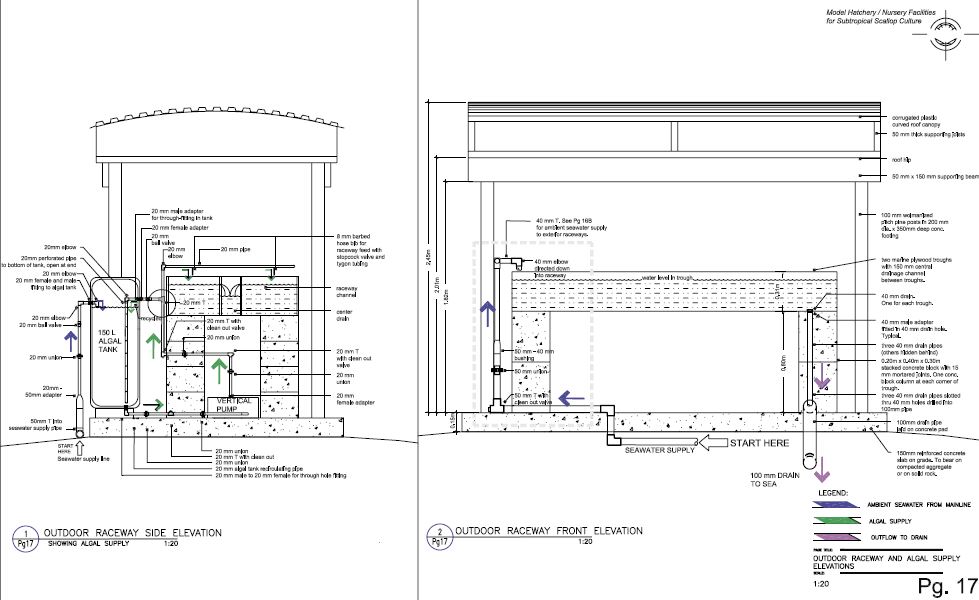
Technical drawing, Pg. 18
Outdoor raceway: Algal and seawater supply photographs
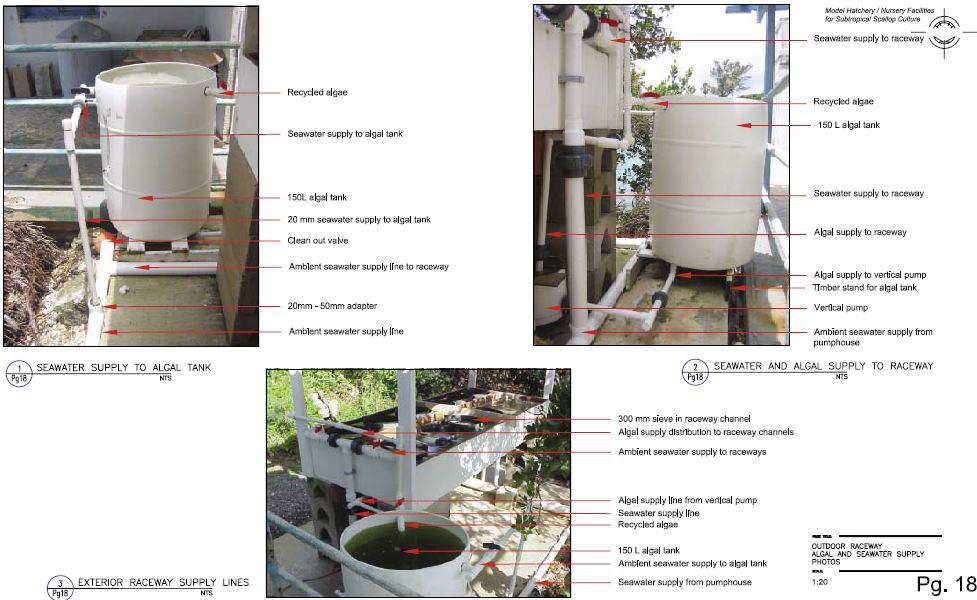
20 mm adapter. A 20 mm union fitted in line allows for removal of tank and cleaning of pipes when necessary. Flow is regulated by a 20 mm ball valve; seawater passes through the tank wall, and is directed downward via a 20 mm elbow. Note: A bleed line (7 mm Tygon tubing) for the seawater supply, is put in as a precautionary measure, but was actually never needed; it is not recorded in these diagrams, but can be seen in the technical drawing photo – 1/Pg18).
For algal supply to the raceway channels, algal solution is pumped from the bottom of the 150 litres tank and runs through a 20 mm pipe parallel to the ground. Two 20 mm union are fitted in line close to the algal tank for daily cleaning of the tank. A 20 mm T-junction, capped on one end for cleaning, directs the flow to a quiet vertical pump Fittings for the pump are typical, as described in the technical drawing – page 15, and are supplied with the pump. Algal solution is passed through a 20 mm pipe alongside the raceway wall. Each end is capped by a cleaner valve, facilitating cleaning using a pipe brush. The algal line follows the contour of the raceway channels, running along the width of the channels. For each raceway channel an 8 mm male NPT fitting (hose barb) is threaded into an 8 mm hole. Algal feed is provided through Tygon tubing (7 mm) and regulated by a stopcock valve. Algae are thus continuously injected into the raceway channels at the point of seawater inflow. As pressure from the pump is high, and flow of algae restricted into raceway, an overflow valve is fitted following a T-junction (at the top of the algal tank) in the algal supply line; excess algae is thus passed through a 20 mm pipe through the tank wall for recycling. Any excess algae is mixed into the tank, as it is forced through a 20 mm perforated pipe running the length of the 150 litres tank, stopping 25 mm off the bottom.
The elevation view for the entire raceway also depicts the roof of the raceway and its wooden framework supporting the canopy, the stacked concrete blocks elevating the raceway to waist level, the concrete pad and seawater inflow and outflow. The framework supporting the canopy drawn is a sound engineering design and differs to that quickly constructed at the Bermuda hatchery (see technical drawing photo – 2/Pg16).
Technical drawings photos – 2/Pg18 and 3/Pg18 clearly illustrate the location of the algal supply line relative to the seawater supply line.
4.1.3 Circular tanks
Refer to Technical Drawings – page 7, 19A and page 19B. The seawater and air supply lines for all tanks including the circular tanks described in this section are shown in a general ceiling plan in technical drawing – page 7. As a reminder, ambient seawater lines (coded blue) and heated seawater lines (coded red) run parallel to each other along the length of the container.
Refer to technical drawing – 1/page 7. Circular tanks are connected to both the heated seawater line and ambient seawater line via three connections. Ambient seawater, filtered to 1 µm, is diverted from the main line via a 40 mm T-junction; for the first connection, seawater is directed to the left, for the other two connections, seawater is directed to the right). The end of the 1 µm filtered seawater line is capped). All connections are similarly fitted, and details of one connection are shown in the technical drawing photo – 1/Pg19A. The connections are identical for both heated and seawater line. In-line of main supply pipes a 40 mm T diverts the flow of water downwards towards the circular tank. A 40 mm to 25 mm bushing reduces the circular tank line to 25 mm. The flow of seawater is regulated by a 25 mm one-way ball valve, glued to an elbow. This elbow allows for ambient seawater to flow into the circular tank. A 25 mm union is glued in line for cleaning and/or replacing of parts. After the union is a 25 mm T-junction directing the water flow to the circular tank and connecting this inflow
Technical drawing, Pg. 19A
Circular tanks: Plan and elevation

pipe to the heated seawater line. Inflow is regulated by a 25 mm valve and water is distributed at surface of tank.
Refer to technical drawing – Page 19A. The tanks used are of 1 m inner diameter fiberglass with a 10 cm wide top lip, 68 cm high and a 15 mm tapered bottom with a 50 mm centre threaded drain. A 30 cm skirt was added by the company (Red Ewald Inc.). See technical drawing diagram – 3/Pg19A. Interior of tanks was coated with blue gel coat and exterior was of grey pigment. A 50 mm standpipe of 80 cm length is used for overflow. The total capacity of the tank is 450 litres. For drainage a 50 mm drain is fitted with a 50 mm male adapter glued to a 50 mm elbow directing the drain pipe parallel to the floor. The remainder of the line is reduced to 25 mm with a 50 mm to 25 mm bushing. The plan view (see technical drawing – 2/Pg19A) shows the remainder of the connection. The 25 mm pipe extends throughout a ready-made hole in the skirt of the tank and connects to a 25 mm T-junction. This T-junction allows either for collection of swimming non-fixed spat during water exchange, or diverts the outflow to an exterior 100 mm drain system. For the collection of swimming spat, flow is controlled by a one-way 25 mm ball valve fitted with an elbow. A flexible hose is attached to the elbow during collection. For drainage to the outside a mirror system on the opposite side of the T-junction is installed; similarly a one-way 25 mm ball valve regulates the outflow. A 25 mm union allows for cleaning of the system and connects to a T-junction. This junction is the intersection of drainage pipe for two 450 litres tanks. Water is sent to the exterior drain through the container wall.
The 450 litre tanks can be set up as an open, semi-recirculating or recirculating system, useful during spat settlement. Technical drawing photo – 4/Pg19B shows the set-up for an open system where seawater is continuously supplied via a 25 mm pipe; for this, outflow valves are opened completely, and collecting valves closed. Technical drawing photo – 5/Pg19B illustrates the set-up for a semi-recirculating or recirculating system. Four 25 mm pipes of the same height as the tank are vertically placed at opposite ends of the tank and connected together using two T-junctions and four 25 mm transverse pipe lengths in the centre. Additionally, four 100 mm long standpipes are fitted to each vertical pipe via a 25 mm T-junction. The centre 25 mm transverse pipes are drilled with 8 mm diameter holes. An airlift system is achieved by a 7 mm ID Tygon tube connected to the airline and inserted into a vertical pipe for its entire length. In this way recirculation of water is created, where water from the bottom of the tank is driven by air up the vertical pipe, and flow out through the holes of the transverse pipe. It is found that two airlines inserted in two vertical pipes provide sufficient airlift.